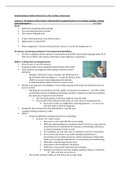Aantekeningen Student Diversity in the (incluse) classroom
Lecture 1: In support of the learner with specific learning disorders (in reading, spelling, writing
and mathematics) 8-2-2023
Exam
Reflection, integrating of knowledge
You can bring all sources you like
The courses will guide you
4 open-ended questions (2 by both teachers)
Digital space to upload files
Home assignment: 6 articles with questions, choose 1 to write the assignment on
Prevalence of learning problems & developmental disabilities
AD(H)D; reading problems; dyslexia (comorbidity with ADHD); dyscalculia; language delay; NLD;
ASD; fear of failure/test anxiety; depression (super high due to pandemic)
DSM-5: A 08 Specific Learning Disorder
Does not have to do with memory
Integrated point of view, taking the whole history of the child
Some children are diagnosed with dyslexia without a proper
indication
o Example: child from Turkey coming to the Netherlands at
age 8 it hasn’t had schooling yet so take the history of the
child into account when diagnosing with dyslexia
o A child should have had the chance to learn to read
Having an incongruence in intelligence and reading capacity used to give an indication, but now
more is needed
o Checking the school history and the quality of education you followed provide a child
an individual project of additional schooling, and after 6 months you will check whether
the child has a response to intervention
The form and quality of education might not suit the child
If you profit of the additional education, you don’t have a learning disorder
If you don’t profit, you might have a learning disorder so can be the
path that leads to dyslexia diagnosis
Normal IQ, they can learn but they fall behind in 1 specific area
(reading/writing/arithmetic/math)
DSM-5:
o Persistent difficulties during formal years of schooling
At least 1 of 7 other criteria
1. Inaccurate or slow and effortful word reading
2. Difficulty understanding the meaning of what is read (e.g., may read text
accurately but not understand the sequence, relationships, inferences,
or deeper meanings of what is read)
3. Poor spelling (e.g., may add, omit, or substitute vowels or consonants)
4. Poor written expression (e.g., makes multiple grammatical or
punctuation errors within sentences, written expression of ideas lack
clarity, poor paragraph organization, or excessively poor handwriting).
5. Difficulties remembering number facts
6. Inaccurate or slow arithmetic calculation
7. Ineffective or inaccurate mathematical reasoning.
8. Avoidance of activities requiring reading, spelling, writing, or arithmetic.
This criterium was removed
o The specific academic skills are well-below the average range
, o The learning difficulties are not better explained by other disorders or delays
o The learning difficulties significantly interfere with academic achievement
Innate problems with the definition and operationalization of ‘persistent difficulties’
Learning difficulties depend on the teacher
o Is ‘didactic resistance’ a diagnostic criterion? And does it inform us about the severity of
the problem?
A Theoretical Model Regarding the Brain Circuits for Reading (Pugh, Shaywitz, Eden, Simos)
Each area has specific contributions to reading and spelling
o Broca:
Phonological processing: articulatory mapping
o Wernicke:
Phonological processing: correspondence between letter and sound
o Angular gyrus:
Relay station; crossmodality integration
o Visual association:
Graphemic analysis
Dyslexia is usually associated with insufficient phonological processing (PA) (match between the
sign and sound) and rapid automatized naming (RAN) (fluency character)
o RAN: the learning difficulty also influences the speed of information processing, even
when it’s with something that doesn’t have words (for example, processing information
in traffic)
o Children that have difficulties with PA + RAN have double-deficit hypothesis
Reading also relates to mathematics
Implications for practice: repetition and practice
Look for clinical signs
Preschool/kindergarten
o Confusion over direction of words (left/right; under/over; before/after) work in
accordance to each other
Also relates to mirroring effect in math
o Failure to identify letter sounds in words or identify basic rhymes
o Mix up sounds in some words (saying “aminal” instead of “animal”)
Primary education
o Unable to sound out words
o Difficulty reading words that are not part of a sentence or have no picture clues
o Pronounce the letters in a difference sequence than what they naturally are (who/how)
o Misspell words even when copying them visually
o Difficulty with any type of rote memorization (learning multiplication tables, memorizing
science facts or history facts, e.g., dates, names)
The amount of energy a child has/time of day tremendously influences abilities, so take that into
consideration!
, Child with dyslexia has a slow-down in processing the words and letters by processing way more
in the right hemisphere
Grey line is RAN, black line is PA
o Weak readers depend way more on PA than RAN, they decode words in small pieces
o Strong readers depend way more on RAN than PA, they have a more global sense of
words and sentences
For weak readers, PA is very important to start
o They invest more in accurate reading in a slow pace
o After that they can invest in speeding up
For strong readers, fluency component is most important
5 crucial basic cognitive processes in reading
Phonological processing
o Grapheme-phoneme correspondence; vowels – consonants





